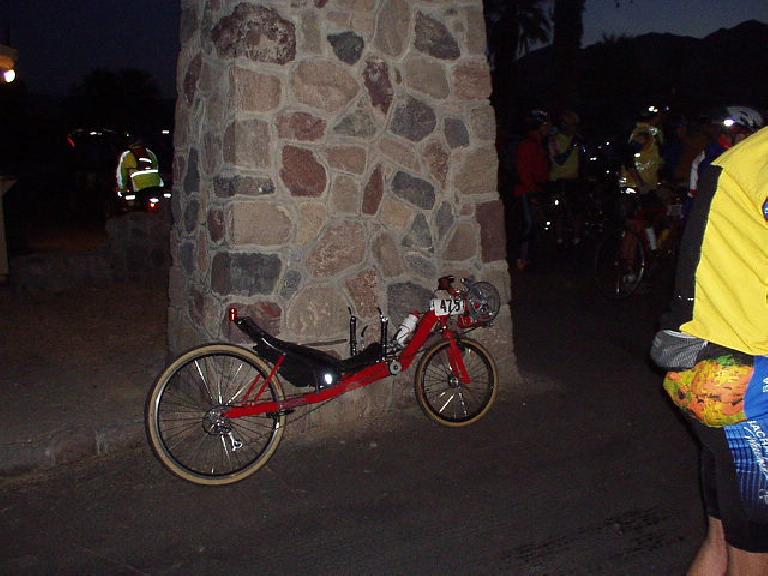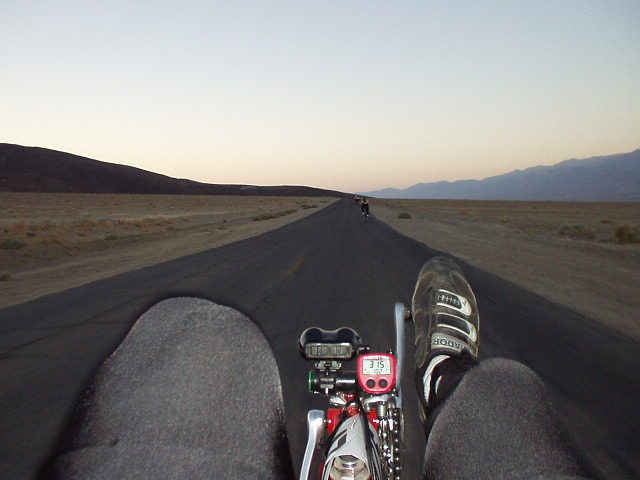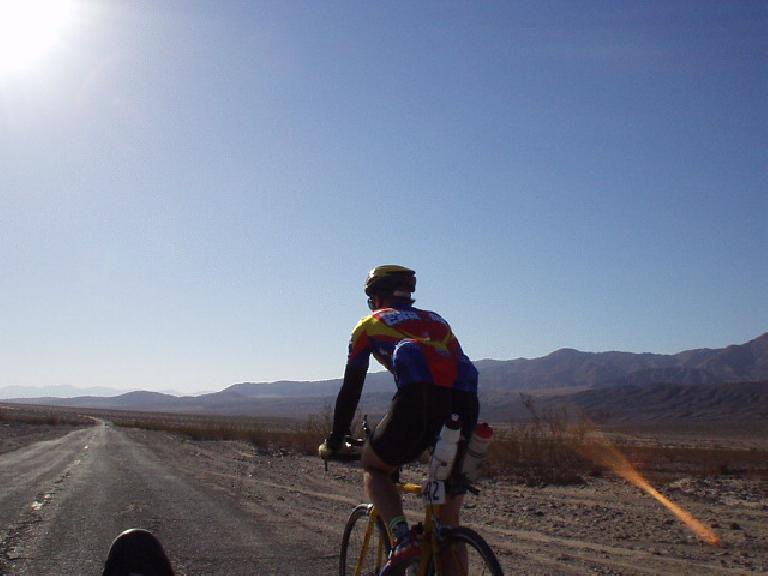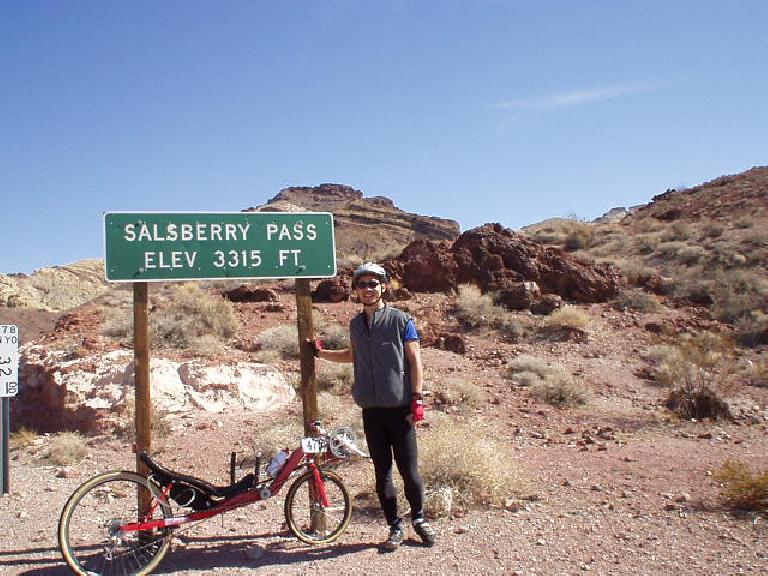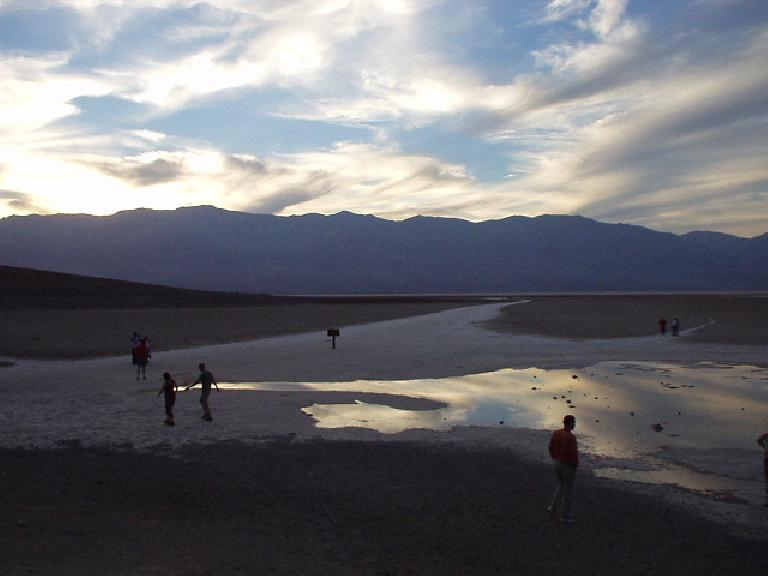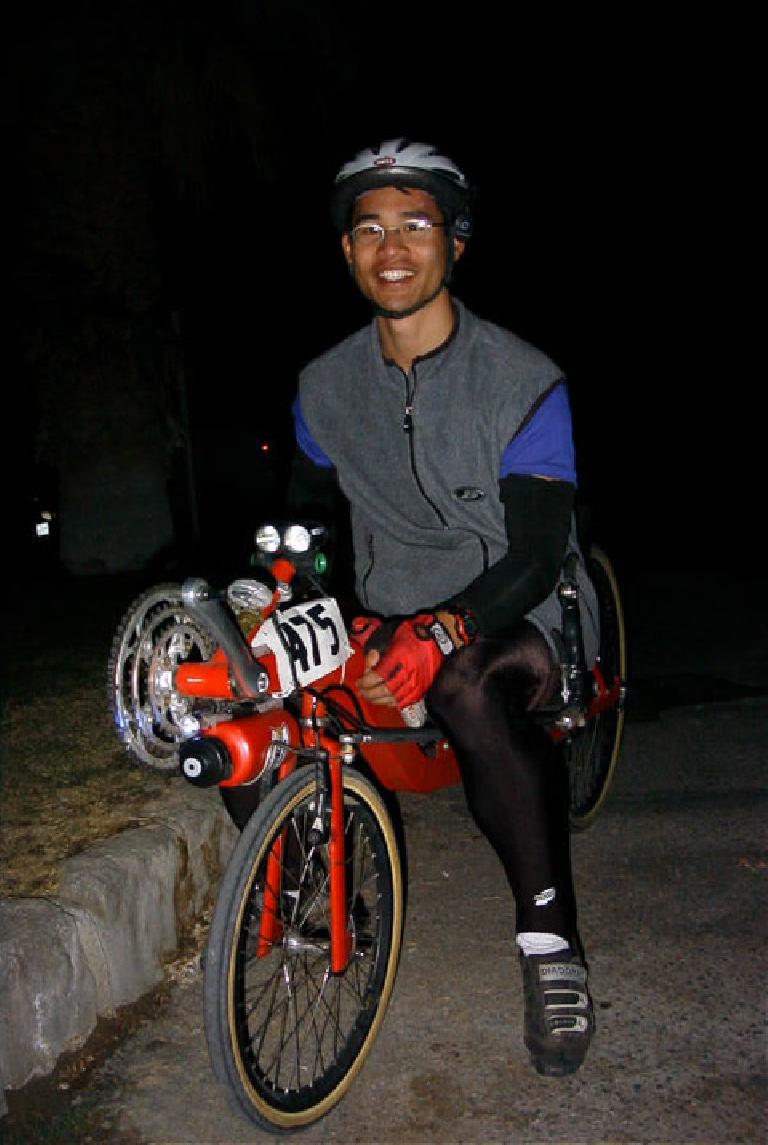Death Valley Double Century
It was a matter of redemption. The very first organized bike ride–or any ride over 20 miles for that matter–that I ever attempted on the recumbent was the 2000 Death Valley Double. It was a gallant effort, including successfully cresting the summit of Salsberry Pass two times, but due to woefully inadequate lighting and the resultant episodes of off-roading and falling, I bailed at Mile 150, with 50 miles to go.
Almost 2 years later, then–with the added incentive of needing to do one more double century to earn yet another California Triple Crown–it was time to return to the site that had the dubious distinction of myself needing to be plucked up by a SAG vehicle for the only time in my cycling career. Time to vanquish the dread of not completing my mission that one night 2 years ago. And this time, I’d be well equipped with two lights: my high-powered Cygolight with a 2.5-hour burn time, and a new, 3-blue-LED “Tek Torch” that’s “10 times as bright” than a conventional flashlight and yet has an astounding 200 hours of battery life! Bring on the darkness of Death Valley!
The Drive
As in 2000, I put in a near-full day at work, working from 6:00 a.m. to noon. Then I rushed home, went over to the local Avis rental car company in which I had made a reservation for a compact car, and within 2 minutes was out with a… Chevrolet Malibu. Apparently Avis had run out of compact cars so they gave me a family-sized car for no extra charge. I used an “Amateur Sports Assistance Program” (how appropriate!) promotional code (D002807) I found on the internet and made a reservation online for just $72 for 3 days, no questions asked! What a great deal and great service! I would highly recommend Avis, and particularly the Fremont Avis, to anyone.
Unfortunately, despite the Malibu having a cavernous trunk… it could not swallow my recumbent due to GM’s curious decision not to enable the rear seat to fold down. Not wanting to to disassemble my recumbent (one of the motivations for renting a car in the first place), I thus placed it in the trunk (with the rear wheel sticking out) and kept the trunklid half-way closed with a couple of bungee cords. That did it. This also completely blocked my view to the rear from the driver’s seat, but judicious use of the side mirrors enabled me to drive safely.
After this entire ordeal, including packing, I finally left Fremont at about 3:00 p.m. Earlier in the morning I had conferred with my friend Adam Paul, asking him if taking the Sonora Pass route to Death Valley wouldn’t take too much longer than going through Tioga Pass (since I was hoping to save the $20). He thought it would take a lot longer, and hence suggested taking Highway 4, which was slightly farther north, but was “pretty quick all the way to 395”. I crossed my fingers…
…and drove non-stop, only stopping very quickly for a bite to eat at Taco Bell and a couple of times for gas. Yet, the traffic out of the Bay Area was bad, and Highway 4 was slow going for the big Malibu, with steep grades and too many hairpin turns for spirited driving. Finally, after I reached 395, the drive was much quicker, but too much time was lost already. All in all, the drive via Highway 4 from Fremont was 505 miles, and 10 hours. This took longer than the 550 miles and 9.5 hours via Bakersfield from Fremont in 2000!
The Ride
Miles 0-45
As usual, I got a good night’s sleep in the car (ha!) Actually, the night was a pleasant temperature–a nice surprise, as I had half-expected it to be freezing here in the desert in November. I woke up at 5:00 a.m., changed, and was over to the Furnace Creek Resort, where I awaited the 6:00 a.m. start, preluded by general info, warnings, and words of encouragement from Planet Ultra’s Chris Kostman, the organizer of the event.
By 6:05 a.m. there was already plenty of daylight, and it was here I heard someone say my name. It was my friend Russ of the Tri-City Tri Club, with Steve right behind. I had been wondering where they were, as I did not see them at the start. We chatted briefly, but then there was a low-angle-but-long downhill, and wanting to make as good time as possible before hitting Jubillee and Salsberry passes later in the day, I was off.
The weather was glorious: crisp, clear, with little wind. The sun loomed above the stark desert scenery, and it was hard to believe that it was November. We basked in the light, but not baked.
A pattern soon emerged in sharing the road with the other cyclists: I would pass them (all on conventional diamond frames) on the slight descents and flats, but on the slight uphills, they would catch up and pass me. We seemed to play leapfrog with each other constantly. “Hi again!” was a common saying for the morning.
At the first checkpoint, in Badwater at Mile 18, I stopped briefly to make a bathroom stop, and was back on the bike. I would not repeat the mistake of staying for 15 minutes at each rest stop as I did in 2000!
I seemed to be drinking more than enough, however, as I’d have to stop at a bush just an hour later or so. Here, Russ and Steve would later tell me, they had just about caught up to me, but when I got going again on the downhills, they’d drift behind again. I had no doubt, however, that by the time Jubilee and Salsberry came, they would catch up, so I carried on at a fairly rapid pace.
Checkpoint #2: Ashford Mills. Knowing that Jubilee and Salsberry would be just up ahead and constitute perhaps 2.5 hours of riding, I filled up my hydration pack all the way even though it was only about half-empty. Here I met one other rider on a recumbent: a faired Gold Rush who came in just a few minutes after I did. I wished him luck and soon I was off, again.
Miles 45-74
Sometime while I was at the stop Russ and Steve had pulled in, and we all left the checkpoint together. We rode for about 10-15 minutes together while discussing our motivation for not wanting to stop for long period of times. “Planet Ultra is no-frills,” observed Steve, who had experience with them during both the Solvang Double earlier in the year, “and probably won’t be serving dinner at the end. So we want to get back to the restaurant at the Furnace Creek Resort before they close at 9:30!” My motivations were slightly different: I knew that on the ‘bent I would be lagging behind on the ultra-long climbs ahead. Thus, I wanted to get to them after making some good time, then survive them, and afterwards, make up lost time on the ensuing flats and rolling terrain. By doing so, I figured I should be fairly comfortably able to make the 17-hour time limit.
As expected, by the time the ascent to Jubilee begun, I was off the back, and unlike on the Mt. Hamilton training ride a few weeks ago, I was unable to keep up with Russ and Steve. But I soldiered on, and definitely was able to keep a faster and steadier pace than 2 years ago. I was not passing anyone, but I was fairly pleased with how I was riding.
And 2 hours later… Salsberry down! This was a whole lot faster than in 2000, and I was now very encouraged. I really was happy there was going to be a descent.
The descent to Shoshone, though, was not nearly as long as I had remembered. In fact, after about 6 miles or so of a descent, it seemed to be going uphill again. No fair!
It was somewhere here I saw Russ and Steve again, going in the other direction. Just a few miles from Shoshone. This seemed to confirm to me that I wasn’t making horrible time, since I estimated I was just about 30 minutes behind them. I was about not to slow down, though… so at Shoshone, I stopped for 4 minutes, max!
Miles 74-103
“One more time up Salsberry,” I thought to myself. I thought back to 2000, when this leg was later in the day (the course is sort of reversed in Spring), and despite making it up the pass, it was just after this leg I had to concede defeat when darkness had completely set in. Back then getting up Salsberry again wasn’t my greatest concern, but getting down it safely was. My mindset this year was somewhat similar–looking beyond the pass, though the task of going up it was not insignificant.
I took off from Shoshone about the same time as 4 or 5 other cyclists. This would serve as a good gauge of how the bent would fare compared to a conventional bike, as 1/3rd of the leg was uphill, and 2/3rds of the leg was downhill. I had lost time to the conventional bikes on the way to Shoshone; I was sure hoping I would make up some time on the way back!
I started off okay, breezing by one of the cyclists I had started just after on a downhill. “Hey, cheater!” the guy yelled at me. He was probably joking, but I did not exactly appreciate this. Just because I had an aerodynamic advantage on the downhills, I was certainly not “cheating”, especially considering the significant ergonomic and weight disadvantage on the uphills. I do think that he realized as, on the ensuing ascent, he fairly easily caught up to me, and seeing that I was indeed working here, he gave me a good cheer.
The climb up the backside of Salsberry was long and hard. Not nearly as long as the frontside, of course, but it was certainly putting the hurt on me. But finally… made it. “Finally!” I remarked to a female cyclist on the other side of the road at to the top, acknowledging that the worst was indeed over.
And now… the best descent of the day! Nearly 17 miles of downhill, only interrupted by a short climb up the backside of Jubilee. The cyclists I had started with had long dropped me on the climb up the backside of Salsberry, but after maybe 15 minutes of the descent in which I was easily cruising at 35 mph+, I had caught up to them. At Jubilee I caught some other cyclists. Things were looking good!
But in the brief moments I was pedalling, I could feel that something was not quite right with my legs. My right leg had a sharp pain on the inside whenever I’d pedal, and my left shin, oddly enough, was very sore–like it was after running The Relay the month before. Would it affect me during the rest of the ride, I asked myself. A good question, considering that after the rest stop I’d get to shortly at Ashford Mills, there were still 93 or so miles to go!
Miles 103-149
I stopped at the Ashford Mills rest stop just long enough to fill up my hydration pack and grab some food (pretzels, PowerBars). As I took off, the guys staffing the station good-naturedly called out after noticing how laid-back the recumbent position was, “You can’t go lying down on the job all the time, you bum!” Indeed, with the hills now behind, with the aerodynamic advantage afforded by the recumbent, it was supposed to be my turn to make up some time.
But something was very wrong. My legs had seemingly nothing in them, with the exception of sharp pains here and there. Thinking that my problem must have been hydration–or rather, the lack of– I resolved I would have to drink more. And drink more, I did.
Next problem, though: fluid was seemingly going right through me, and several times until the Badwater checkpoint at Mile 131, I’d have to stop to go water some trees!
I wasn’t able to retain any water at all, it seemed. Indeed, I probably set the world’s record as to how many times I needed to take a leak in an hour. The problem, I theorized, was that I had eaten very little “spongy” food to retain water in my stomach, such as bread. Most of the day, I had just been consuming Clif and granola bars. I also was consuming very little salt. I resolved that at the next checkpoint, I was going to have to load up on peanut butter and jelly sandwiches (for both bread and the salt).
Other food matters: the “classic” PowerBars are ridiculous! They taste pretty good (though on a really cold day, I imagine they would be almost impossible to chew as they’d be so hard), but their wrappers are an abomination. Supposedly, in the late 90s (after a decade, when the PowerBar guys started to get a clue), the wrapper was changed to an “easy-to-open” type from the original kind that was difficult to open with two hands. Yet, this new-style wrapper was not much easier to open! It’s still difficult to tear the wrapper, and–this is the major part–the foodbar itself is so sticky, it makes peeling away the wrapper from the bar difficult. After a couple of minutes trying to open the darn thing as I was riding, I stopped *just to be able to use both of my hands to open it*. For this reason, I still cannot patronize PowerBar, though I’d like to being the originator of the entire “power bar” industry.
Anyhow, slowly but surely I made it to the Badwater stop. Supposedly, they had some turkey sandwiches over there that, I’d hear later, were excellent. Instead, however, I chucked down a Coke, grabbed some peanut butter and jelly sandwiches, and was off. I stopped for 5 minutes at most.
And after that stop, I was still not feeling strong or fast, but at least better than in the last leg. Darkness was setting in. I really wanted to conserve my high-powered lights for the last 30 miles of the ride, as I knew the burn time on them was only 2.5 hours. Yet, when I had to start using lights, I was only at Mile 140 or so. Hence I used only the 3-blue-LED “Tek Torch” light with the 200-hour burn time at this juncture.
The Tek Torch proved to be adequate even without a moon out. At least this year the stars were out, unlike in 2000; the roads seemed to have some more visible lines on them than 2 years ago, too. I wouldn’t be riding off the road this year.
At last… Furnace Creek. Some people were bailing here. Yet, my spirits were up. Now it was just a matter of going to Stovepipe Wells and back. I sort of knew the route having done it in the first 50 miles of the 2000 Death Valley Double, plus driving it on the way to the ride. About 48 miles to go. The final stretch.
Miles 149-197
I continued my strategy of using mostly the blue-LED light except for the gradual downhills, where my speed (and need for better lighting) was greater. The latter was rare. I don’t think I ever exceeded much more than 18mph, as the pain in my right knee and my left shin was preventing me from pedalling more than say a minute at a time without coasting a little bit.
I wondered where Russ and Steve were. I figured, as I was on the way to Stovepipe, they were well on their way back. Eventually, about 7 miles out from the Furnace Creek stop, I thought I might have seen them as one of the riders had behind-the-seat Profile water bottle cages. I yelled out “Steve”! No reply. It turned out that though both Steve and Russ had behind-the-seat water bottle cages, they were made by manufacturers other than Profile, and the riders I saw were not them.
Maybe at Mile 160 I could clearly see the lights of Stovepipe Wells. They seemed really close! I was surprised since, though I could not read my odometer in the darkness, I was expecting to have to ride another 12 miles or so still. My instinct proved to be correct when, many miles later, I passed by a road sign that said, “Stovepipe Wells–7 miles”. Disappointed, I continued on. There actually was a bit of climbing to Stovepipe.
Apparently, sometime after that here, Russ and Steve saw the blue-LED light on my recumbent as they rode in the opposite direction back to the finish at Furnace Creek, and yelled out my name. I did not hear them. Focused on Stovepipe, I watched the lights in the distance get closer and closer, slowly but surely.
I finally arrived, and I was ecstatic and only stopped for a couple of minutes to grab some food. Meanwhile some of the guys over there joked about my LED light. “KMart blue light special, eh?” That would not be the last time I heard the Kmart jokes! But the LED light was doing its job, and it was nice to have the assurance that no matter how long I was going to be out there in the desert, it was going to glow strongly.
For the remaining 24 miles back to Furnace Creek, however, I turned on my high-powered light as well. This was it!
On the way back, I did a mental exercise of counting all of the bicyclists still on their way to Stovepipe Wells. Somehow, despite still not feeling physically strong ever since Mile 75, it made me feel better that I was not the last person on the course. In fact, I counted upwards of 25 people until about 8:30 p.m., when presumably, those still not at that point called it a day at the Mile 148 checkpoint, as by that time they were not going to make the 11:00 p.m. finishing deadline.
It was a solo ride back in solitude for me. On the way back, other than the riders who were going the opposite direction to Stovepipe Wells, I only saw about 4 riders (all whom passed me up at some point). And my high-powered lights did finally go out, with maybe about 5 miles to go, making me rely solely on the LED one once again.
But the air temperature was nice–cool, but not frigid–and the last leg was probably the most enjoyable part of the day aside since the first 50 miles of the ride when I was feeling fresh and strong. Here in the darkness, the stark desert scenery, or what I could see of it, was nice, a warm reminder that we were well afar from civilization, that this was in fact a mini-vacation.
But it was more than a mini-vacation for me. It was a matter of redemption for the DNF of 2000; it was the culmination of my 5th California Triple Crown. And so, with the approach of the lights of the Furnace Creek Resort approaching, I felt warm, happy, and fulfilled. A good end of a great cycling season, my most prolific since 1999. I did it!
Epilogue
At the finish, I chatted with some cyclists while enjoying a warm bowl of Cup-O-Noodles. Amazing how good those $0.75 instant soups taste after about 200 miles of riding. One of the Planet Ultra hostesses who had remembered me from other rides (e.g., the 2002 Heartbreak Double was surprised to see me on my recumbent. “That’s not your normal bike, is it?” she asked. Indeed, it was the first ultra-cycling ride I’ve done all year on it, but a fun way to add a different dimension to the sport I love. I remarked that though the course was not too bad for the recumbent, I thought I might have made better time on my Cannondale, if only because “I was so wasted after going up Salsberry twice that when the course flattened out, I just didn’t have it in me to ride well and make up some time.”
As I was talking, there was Steve and Russ in Steve’s truck making it’s way out to Stovepipe Wells, where they were going to stay for the night. Apparently, they finish almost exactly one hour before I did, hammering away in the last half. I was really glad to see them and was proud that, they too, had completed the California Triple Crown this year (their first!)
Would I do the Death Valley Double again? This was my 3rd time doing the ride (in addition to 2000, I did it in 1997″ on the ‘dale.) Interestingly, the course was different each one of those times, and the experience and memories were very different. Each one has been its own story in itself. But really, it’s a long way out, one of the more expensive trips to make, at least from the San Francisco Bay Area. Hence, it may be many more years before I do it again. It’s hard for me to say “never again” considering that there have been a few times I have said that (e.g., with the Terrible Two and the Devil Mountain Double), and yet I returned. Cycling can be an obsession as much as a passion for me.
With the season over, however, it was time to enjoy other things. I celebrated the ride by making a detour down to Gorman–where I had been a couple of months before for the 2002 Heartbreak Double–to climb Mt. Pinos and Sawmill Mountain, the highest points in Ventura and Kern Counties. It was very leisurely compared to the double century!
Ride Data
- 197 mi
- 6:00 a.m. mass start, 9:25 p.m. finish—15.4 hours
- Average Speed: 13.1 mph moving, 12.8 mph overall
- Max Speed: >40 mph
- Total Climbing: 8,000 feet
Rating
(5=best)
- Scenery: 3. Beautiful desert scenery, but monotonous.
- Support/Organization: 3. Planet Ultra is somewhat no-frills, but the services they do supply are near-top notch.
- Food: 2+. Not much variety in food; little “real” food aside from peanut-butter-and-jelly sandwiches
- Weather: 4. 50-75 degrees all day, with manageable winds; I cannot imagine it the weather being any better in Death Valley. Too bad there’s only 11 hours of daylight at this time of year.
- Relative Difficulty: 3. All of the course is flat or rolling–except for the climbs up Jubilee and Salsberry Pass. The latter is ridiculously long!
- Overall Rating: 4. Near-ideal ride conditions. I just wish my body held up better!
Route Sheet (PDF)
